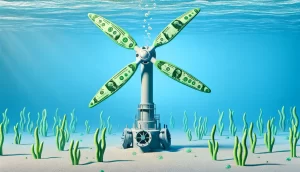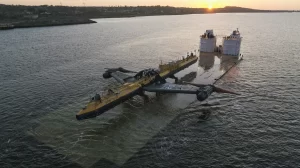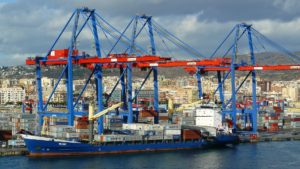The ocean is a gigantic reservoir of energy. Why aren’t we using more of it? Like so many relationship statuses on Facebook: it’s complicated. In my last post I hope I convinced you why we need marine renewables. In this post I’ll discuss why we don’t see more on the grid.
To understand the barriers to adoption for marine renewable energy devices we need to understand the technology and economics behind them. These two factors are inextricably connected. It’s like Clinton and Trump (too soon?): you can’t talk about one without mentioning the other. I’ll also touch on social and environmental issues that can also cause headaches for developers. In this post I use a causal loop diagram, if you’re unfamiliar with these then head over to this page to learn how to read them, I’ll be using more of them in future posts.
A simple way of gauging the maturity of a technology is to use a scale known as the Technology Readiness Level (TRL). NASA invented it so you know it must be good. The scale runs from one to ten; one is essentially a drawing on the back of a napkin while ten is a proven and reliable design that is operating at scale in the real world.
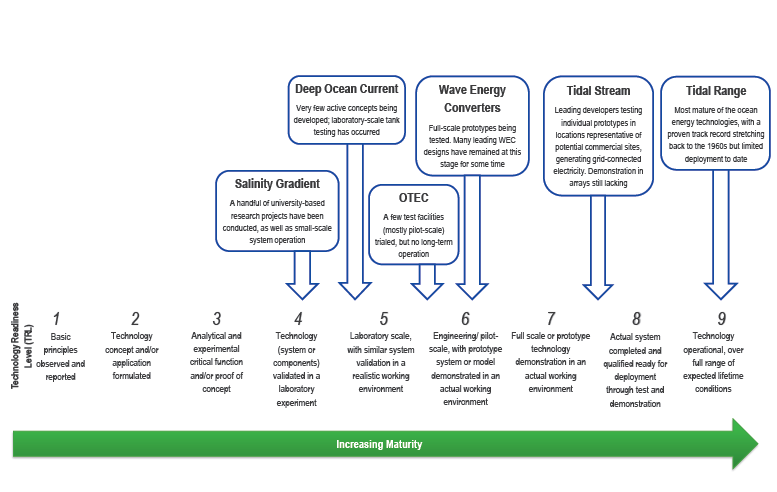
This chart comes from the International Renewable Energy Agency and was produced in 2014, but it still holds true today. Most of the marine renewable energy family is on the left; this means they still have some growing-up to do.
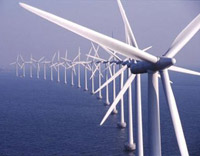
What happens when you move up the TRL scale? Let’s use the iconic three-blade wind turbine as an example. This iconic design is ubiquitous for wind developers. Every time it’s used, small design changes are researched and implemented to increase efficiencies. This results in a slightly better system and one that is more appealing to customers. In other words, this wind turbine design is in a virtuous feedback loop.
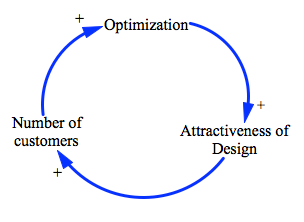
There are hundreds, if not thousands, of different designs for wave energy conversion, but not a single one that the industry has rallied behind. George Hagerman, a contributor to the Department of Energy assessment on wave energy, put it nicely: “no one seems to have settled on a design that is robust, reliable, and efficient.” Consequently no one design is benefitting from years of focused R&D. It is more of a shotgun effect where R&D is spread across many different designs. No loop!
Why haven’t we found that optimal design yet? Well for starters, the ocean is mean. Like a three year-old toddler it wants to destroy everything. Marine engineers need to deal with material fatigue from pounding waves, corrosion from saltwater, biological growth from algae and barnacles, floating debris like plastic bags blocking pipes, pressure at depths, and water getting into sensitive electronics. Then there are the wind and currents that are constantly pushing and pulling the device in directions that it shouldn’t be going. Like I said, the ocean is mean.
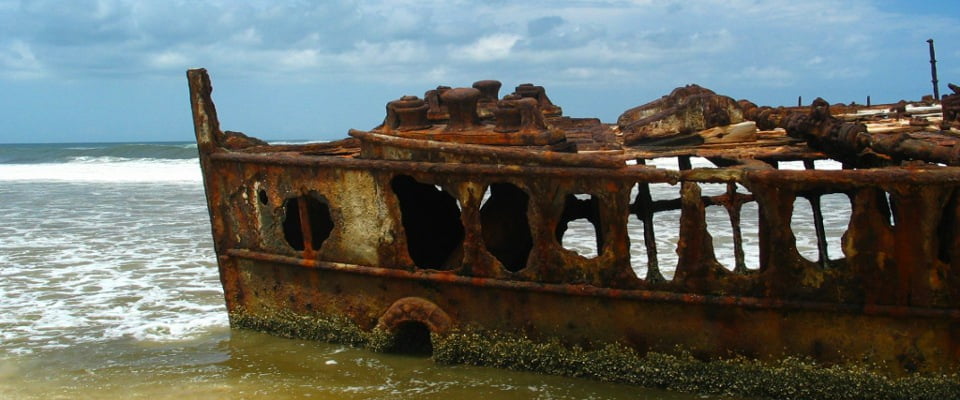
A project can be the most technologically beautiful thing that ever existed, but if the economics don’t support it then no one else will either. Costs matter. If I learned anything in business school it’s that costs can be grouped into one of two categories: fixed or variable.
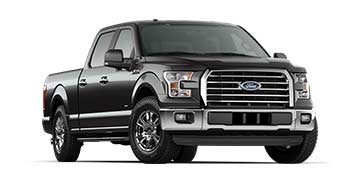
Pretend you are going to buy a shiny, new Ford F-150 pick-up truck. The price you pay the dealership to buy the truck is a fixed cost, also known as a capital expenditure (CAPEX). The money you shell out for gas (and shell it out you will) and maintenance are all variable costs or operating expenditures (OPEX); they are recurring and vary with the amount of use. Let’s get an idea of what CAPEX and OPEX look like for a marine renewable energy developer.
CAPEX includes development, installation, infrastructure, mooring and foundation, system components, and bribes (kidding). Installations for these devices can be tricky. Developers need to work around the wind, waves, and tides to find that ethereal time slot when the ocean is placid; akin to finding a nice quiet spot in Time’s Square.
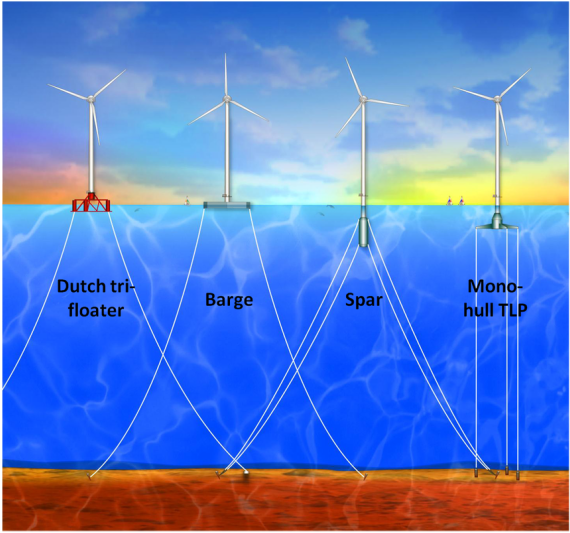
Once a device is built, you need to keep it in a certain spot by mooring it the bottom. This involves elaborate systems of strategically placed anchors and high-tech tethers. The electricity produced by a device in the middle of the ocean is worthless unless there exists the infrastructure to deliver it to the grid. A cable laying ship might be needed to build the infrastructure to shore, and these puppies aren’t cheap.
OPEX includes maintenance, manufacturing, operations, parts, and insurance. Everyone hates these costs because they keep coming back. Just like your new truck needs regular oil changes, the same holds true for marine renewable energy devices. As one can imagine hiring a ship and crew to head offshore and perform maintenance is not as simple, nor as cheap, as changing your truck’s oil at Jiffy Lube. For devices that are underwater specialized divers or remotely operated vehicles may be needed to perform the work, also not cheap.
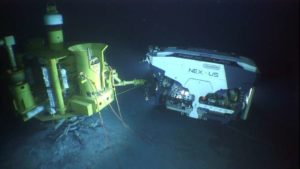
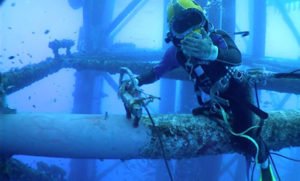
Many of these systems need to be manufactured in specialty machine shops or shipyards due to their scale and logistics issues. Products with low TRLs are by definition not in mass production and each system is a unique butterfly. This is great for marketing, but bad for manufacturing and tooling costs. Instead of spreading the tooling and set-up costs among many units, it’s bore by just a few.
CAPEX and OPEX all contribute to a third cost category to consider, the levelized cost of energy (LCOE). It is the minimum price that the energy must be sold at for the project to break even over its lifetime. The LCOE is the generally accepted method of comparing the costs of different energy sources. For renewables to become competitive they should have a LCOE at or below the LCOE for fossil fuels. If it’s above the going rate there is no economic incentive to shift over. Unfortunately, most marine renewable energy devices have a relatively high LCOE due to the all the issues we’ve just mentioned.
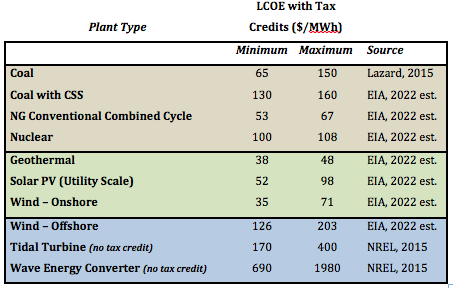
EIA, 2015: https://www.eia.gov/forecasts/aeo/pdf/electricity_generation.pdf
Lazard, 2015: https://www.lazard.com/media/2390/lazards-levelized-cost-of-energy-analysis-90.pdf
NREL, 2015: http://www.nrel.gov/docs/fy15osti/64013.pdf
Most people like the idea of renewable energy, but they are hesitant to see large-scale projects being developed in their back yard. This even has its own name: Nimby-ism, an acronym for “Not in my back yard.” This can cause huge headaches for developers.
In the marine sector, this resistance may come in many forms. Homeowners who have waterfront views typically don’t appreciate the unnatural grandeur of industrial power equipment. See this clip from Comedy Central about opponents to the Cape Wind project. Ports don’t want any devices that will disrupt shipping traffic into their harbors. Commercial fishermen could be worried about limited access to fishing grounds. All fair claims, but this opposition generally results in delays and modified plans, which causes – yup, you guessed it, more money.
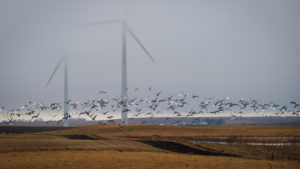
On the whole, renewable energy is better for the planet than energy from fossil fuel sources. But let’s be realistic, nothing is perfect. Just like wind turbines get flak for killing birds, tidal turbines kill fish and other marine life. Devices that are moored to the bottom can damage reefs and bottom composition. Some devices like Ocean Thermal Energy Conversion rely on toxic fluids that can be hazardous to the environment. Tidal devices can change entire tidal ecosystems by altering natural water levels and currents. A thorough environmental impact assessment is needed to understand the unintended consequences, but these take time and money.
Renewable energy devices at sea are technologically more complex than their counterparts on shore. Further innovation and development is needed to find that optimal design for wave energy and OTEC, and only then will these technologies enter that wonderful virtuous feedback loop. Unfortunately R&D isn’t free. Moreover, marine devices incur many unique costs that other forms of renewables don’t have to contend with, especially in maintenance and operations. The good news is that all of these challenges are totally solvable, they just require a little ingenuity and investment.

